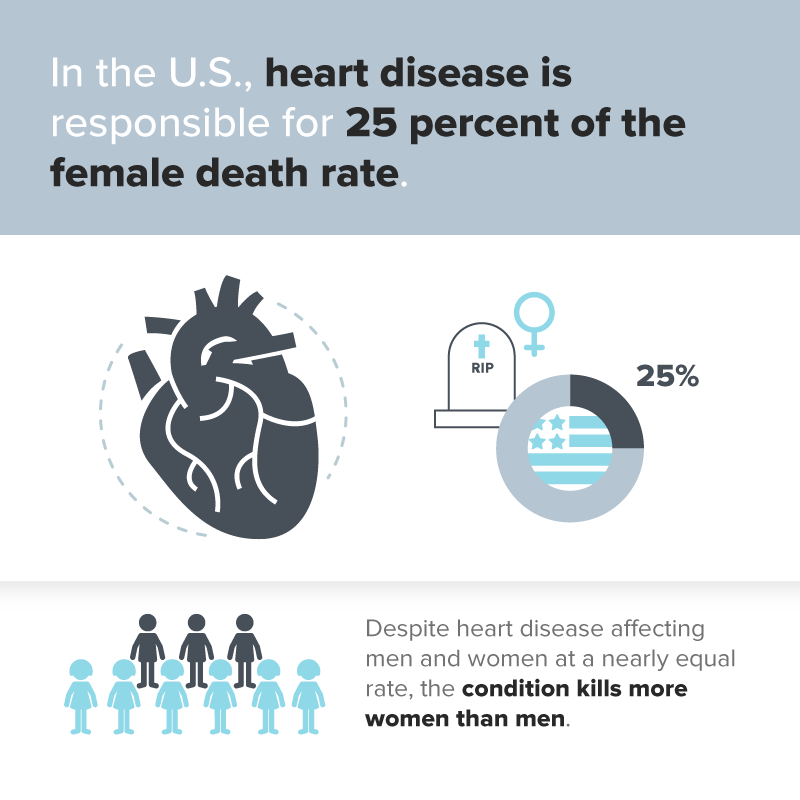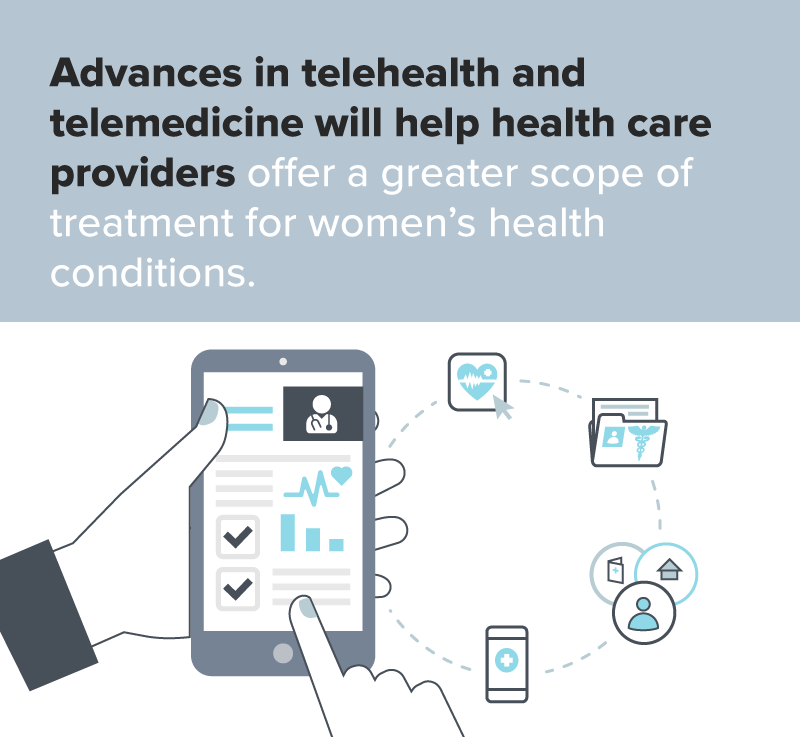Due to genetics, environment, and socioeconomic factors, there are many health concerns that affect women only or affect them to a greater degree than men. (Learn More)
Many kinds of cancer have a very low incidence rate in men, but high chances of developing in women, especially as they age. (Learn More) Women suffer worse effects from a stroke than men. (Learn More) Naturally, reproductive health issues pose particular challenges for women. (Learn More)
Notwithstanding medical, political, and social advances for women’s health, many minority women still experience higher-than-average rates of sexual abuse and violence from their partners, coworkers, and superiors, highlighting the continuing need for awareness surrounding women’s health. (Learn More)
Regardless of race, age, and socioeconomic background, women have unique health issues. Even some of the issues that women share with men affect women differently and require different kinds of treatment.
Unique Health Concerns
Certain illnesses are more concerning for women.
Some of the health concerns unique to women are related to childbirth, such as pregnancy and menopause, and the myriad complications that can arise. In other cases, maintaining and restoring female sexual health is significantly different to addressing issues related to men’s sexual health.
Even when men and women are prone to the same conditions, women can suffer in different ways.
- Heart attacks are more fatal to women than men.
- Women have higher rates of anxiety and depression than men.
- Women suffer more from the effects of sexually transmitted diseases than men.
- Women are affected more by osteoarthritis.
- Urinary tract problems affect more women than men.
Many health conditions that affect women are undiagnosed. Additionally, many drug trials and clinical studies do not include enough female test subjects.
Heart Disease and Cancers
In the U.S., heart disease is responsible for 25 percent of the female death rate. Despite heart disease affecting men and women at a nearly equal rate, the condition kills more women than men, and most women are not aware of this. In addition to not receiving adequate screenings, women also suffer from other conditions that lead to heart disease, such as high blood pressure and high cholesterol.
Breast cancer is the most aggressive form of cancer that affects women around the world. It develops in the lining of the milk ducts, and it can spread to other organs. Since women in developed countries have longer lifespans, breast cancer is more prevalent in the female populations in these countries than in the female populations of developing and underdeveloped countries.
Cervical and ovarian cancer are two distinct health conditions that affect women. Ovarian cancer originates in the fallopian tubes, and cervical cancer develops in the lower uterus. Women suffering from either cancer will experience significant pain. Cervical cancer is associated with discharge and pain during sexual intercourse.
Ovarian cancer does not have symptoms that are as distinct, but it is nonetheless a very complex condition. Its symptoms include changes in appetite, abdominal bloating, increased urination, constipation, increased bowel movements, and fatigue.
As Medical News Today points out, ovarian cancer can be hard to diagnose because its symptoms are similar to those of other conditions.” If they persist for two weeks and no other forms of relief work, women should consult a doctor immediately.

Stroke
Stroke is also a significant risk to women’s health in America. The condition — where the blood flow to the brain is abruptly interrupted, usually by a sudden blockage of arteries or a burst blood vessel — is responsible for 8 percent of all female deaths in the country. It is also the primary cause of long-term disability.
Upward of 55,000 women have strokes every year, and 60 percent of the fatal cases of strokes happen in women. By the numbers, more women than men are affected by strokes.
The National Stroke Association explains that while stroke is the fifth leading cause of death in men, it is the third cause of death for women. Since women tend to live longer than men, they suffer more from the effects of strokes. Their recoveries are more complicated, and they are more likely to have to live in a long-term health care facility after a stroke than men.
Women have certain unique risk factors that can increase their risk for a stroke. General risk factors include a family history of the condition, high blood pressure, diabetes, high cholesterol, smoking, obesity, and lack of exercise. Women are faced with other particular risk factors, like taking certain oral contraceptives (especially as they get older), simply being pregnant, using home replacement therapy, and suffering from migraine headaches.
Reproductive Health Issues
Healthy women will experience bleeding and discharge as natural parts of their respective menstrual cycles. However, health issues are often indicated through the presence of symptoms during menstruation, such as bleeding between cycles and frequent urination. As with ovarian cancer, these can be attributed to other causes and should be looked at.
Health issues related to the vagina and reproductive system could also be a sign of a sexually transmitted disease or cancer of the reproductive tract (one of many kinds of female reproductive cancers, also known as gynecologic cancers). If left unchecked, either because symptoms are not recognized, reluctance to seek medical help, or limited access to health care, these conditions can lead to infertility, organ failure, and death.
Pregnancy issues are a serious concern to women and their families. The hormonal changes induced during pregnancy can exacerbate pre-existing conditions, which could endanger the lives of both mother and unborn child. Other conditions, such as depression, diabetes, and asthma, can be similarly harmful to pregnant women.
Even in women who are otherwise healthy, pregnancy can induce anemia (a drop in red blood cell count) and lead to prenatal depression, which the Washington Post called “the most severe form of maternal depression.”
Autoimmune Diseases and Osteoporosis
Autoimmune diseases can strike both men and women, but it is mostly women who struggle with the condition for reasons that are not fully understood. Some research suggests that the higher prevalence for women to develop autoimmune diseases is “partly attributable to the X chromosome” because many of the genes that relate to the immune system are connected with that chromosome. Other research “links autoimmune diseases with preceding infections,” which are then amplified by key sex hormones.
Another issue affecting women’s health is osteoporosis, a condition where bones are gradually weakened to the point where they can easily break. While a number of factors can cause osteoporosis (including age, genetics, and unhealthy lifestyle habits), women suffer to a greater degree than men.
The National Osteoporosis Foundation writes that 80 percent of the 10 million Americans with osteoporosis are women. A woman has an equal risk of breaking a hip due to osteoporosis as she does developing ovarian, uterine, and breast cancer combined.
Additionally, genetic factors due to sex play a significant role in exposing more women to osteoporosis and its risks.
- Women have a smaller and thinner skeletal structure than men despite both genders having comparable body size, per the Journal of Bone and Mineral Research.
- The hormone in women’s bodies that protects bones, estrogen, drops drastically when women reach menopause, and this can cause bone loss. This is also why the risk of developing osteoporosis increases significantly as women reach menopause age.
There is no recognized cure for osteoporosis, so doctors recommend prescription medication, better diet, lifestyle choices, and dietary supplements as ways to slow down the progression of the condition.
Mental Health
In terms of mental health, women are twice as likely to suffer from depression and anxiety than men. Natural hormonal fluctuations contribute, as do a different female response to stress and socioeconomic factors that are unique to women.
Many low-income women are unable to access mental health care services, which leads to increased rates of depression in this category. Women are also more at risk for physical and sexual abuse than men, which further leads to the prevailing high rates of mental health illnesses among this population.
Alzheimer’s disease is a progressive, degenerative brain disorder that gradually erodes memory and cognitive skills, to the point where even forming the thoughts to carry out the simplest of tasks (eating, getting dressed, going to the bathroom) becomes impossible.
About 4 percent of all female deaths in the United States are due to Alzheimer’s disease, and over 4.5 million Americans who live with the condition are women. At the age of 65, men have a 1 in 11 chance of developing Alzheimer’s disease; for women, the risk at that age is 1 in 6. Women in their 60s are twice as likely to develop Alzheimer’s than they are to develop breast cancer.
Causes include genetics, what one researcher called a “biological underpinning” for women to be more susceptible to the development of Alzheimer’s. Women tend to live longer than men, so it was believed they had a higher likelihood of developing the disease, but more recent research has targeted a particular gene that drives up the risk for women more than that gene does for men.
Genetics and Diabetes
There are many other conditions that pose unique threats to women’s health. With diabetes, for example, the Centers for Disease Control and Prevention writes that women have a four times higher chance of developing heart disease when compared to men, and women tend to have worse outcomes after a heart attack.
Female patients also have a higher risk for developing complications related to diabetes, like depression, kidney disease, and blindness than male patients.
Treatment Advances in 2022
There is reason for optimism. Advances in telehealth and telemedicine will help health care providers offer a greater scope of treatment for women’s health conditions.
Examples include a patient-operated device that prepares female patients for breast reconstruction by using carbon dioxide instead of needles. There is also a blood test that can detect if gestation has started outside the fallopian tubes, potentially leading to early treatment for an ectopic pregnancy.
While many common illnesses can be headed off by adopting healthy habits and making regular visits to primary care providers, these are not always options for women who live in low-income communities. Access to health care may be scarce, and proper eating and exercise may be out of reach.

Great Advancements in Science
At the World Health Organization, Dr. Flavia Bustreo went into detail on the health problems that women face despite many strides in women’s rights and civil liberties. She identified some main issues that pose a threat to women’s health, both globally and within the United States.
Every year, 500,000 women around the world die from cervical cancer, and another 500,000 die from breast cancer. Most of these deaths happen in places where screening, prevention, and treatment are either nonexistent or limited only to the affluent and middle class.
The Kaiser Family Foundation writes that despite screenings and testing being widely available, there are drastic racial disparities in the diagnosis and mortality rates of cervical cancer. African American women have the highest mortality rates for cervical cancer, mostly split among socioeconomic lines. Many women not have access to screenings, or they have never received the health care education to recognize the warning signs and limit their risks.
Reproductive health issues are behind 66 percent of the health concerns of women ages 15 to 44. Unprotected sexual contact is a big driver behind that number, especially in developing countries and regions where sex education is limited or outright restricted.
For example, in “The State of Sex Education in the United States,” the Journal of Adolescent Health explains that notwithstanding “great advancements in science,” adolescents face significant barriers to comprehensive sex education. Other research has correlated this with “the United States ranking first among developed nations in rates of both teenage pregnancy and sexually transmitted diseases.”
Maternal Care and HIV/AIDS
There have been significant improvements in maternal care, to the point that deaths in childbirth have appreciably reduced. However, these improvements are again limited along socioeconomic lines. Around the world, hundreds of thousands of women still die from complications during pregnancy and childbirth.
The AIDS epidemic is almost 40 years old, but today, “it is young women who bear the brunt of new HIV infections,” writes Dr. Bustreo. As recently as 2017, 20 percent of all new cases of HIV/AIDS were women, which is a sharp increase from the period between 2012 and 2017.
Women who are infected with HIV/AIDS are also at risk for tuberculosis, which is one of the leading causes of death among low-income women ages 20 to 59. Traditionally, men have been more at risk to contract and die from tuberculosis, but the effects are usually more severe in women. Even going back to 1996, tuberculosis has been the “leading infectious cause of death in women.”
Violence Against Women
Violence against women remains a significant health care issue in the United States, with both UNICEF USA and Amnesty International noting that minority women are at a heightened risk for abuse from their partners or superiors (for those in the workforce or the military).
African American women experience intimate partner violence at a rate that is 35 percent higher than white women. Immigrant and undocumented women are subject to higher rates of workplace sexual harassment than other women, but they are more likely to withhold reports of these crimes.
Similarly, women in the military are often pressured (or self-pressure) into reporting physical or sexual violence for fear of jeopardizing their enlistment and career progression. Only 29 percent of active duty women who were subject to unwanted sexual contact reported the incident. Many rapes of active duty women go unreported, and female military veterans die by suicide at nearly six times the rate of women in the general population.
For Native American women, the numbers are just as bad. As much as 34 percent of Native women will be the victim of sexual abuse or rape in their lifetimes, while 39 percent of Native women will experience domestic violence.
Women’s Health in 2022
Dr. Bustreo concluded by saying that much progress has been made in women’s health care and treatment. There is significantly more awareness for the unique concerns that women have for their health and much “high-level political will” to increase access to treatment, especially for disenfranchised and underprivileged women and their families.
Nonetheless, the gulf remains massive, and much of the conversation surrounding women’s health and treatment remains rhetorical. Abroad and in the United States, a great many women are denied the opportunity to find out how to take care of themselves and to seek out treatment when necessary. Great strides have been made, some of them as recent as 2019, and more strides need to be taken.
References
Women’s Health. MedlinePlus.
Women’s Health. Harvard Health Publishing.
Health Issues Specific to Women’s Health. Regis College.
Heart Disease in Women: Understand Symptoms and Risk Factors. (January 2019). Mayo Clinic.
Women’s Health, Breast Health: A Review of the Gynecologic Effects of Breast Cancer. (July 2009). Obstetrical & Gynecological Survey.
Human Papillomavirus (HPV) and Cervical Cancer. (April 2013). Healthline.
What Are the First Symptoms of Ovarian Cancer? (June 2018). Medical News Today.
Symptoms of Stroke in Women: How to Identify a Stroke and Seek Help. (June 2018). Healthline.
Women and Stroke. National Stroke Association.
What Causes Bleeding Between Periods? (May 2018). Medical News Today.
What Are the Symptoms of Gynecologic Cancers? (February 2017). Centers for Disease Control and Prevention.
Pregnancy and Medical Conditions. Stanford Children’s Health.
Prenatal Depression May Be the Most Severe Form of Maternal Depression. (August 2016). Washington Post.
Why Are Autoimmune Diseases More Prevalent in Women? (2017). Tidsskr Nor Legeforen.
Women and Autoimmune Diseases. (November 2004). Emerging Infectious Diseases.
Males Have Larger Skeletal Size and Bone Mass Than Females, Despite Comparable Body Size. (March 2005). Journal of Bone and Mineral Research.
How Estrogen Protects Bones. (March 2007). Science Daily.
Depression in Women: Understanding the Gender Gap. (January 2019). Mayo Clinic.
Why Does Alzheimer’s Pose a Greater Risk for Women Than Men? (February 2019). Healthline.
Why Women Have More Alzheimer’s Disease Than Men: Gender and Mitochondrial Toxicity of Amyloid-beta Peptide. (2010). Journal of Alzheimer’s Disease.
New Clues on Why Women’s Alzheimer’s Risk Differs From Men’s. (July 2019). STAT.
Alzheimer’s Genes: Are You at Risk? (April 2019). Mayo Clinic.
Diabetes and Women. (April 2018). Centers for Disease Control and Prevention.
Two-stage Prosthetic Prepectoral Breast Reconstruction: Comparing Tissue Expansion With Carbon Dioxide And Saline. (March 2019). Plastic And Reconstructive Surgery. Global Open.
Ectopic Pregnancy. (May 2018). Mayo Clinic.
Health Care Costs Are a Barrier to Care for Many Women. (January 2015). Urban Institute Health Policy Center.
Women’s Coverage, Access, and Affordability: Key Findings From the 2017 Kaiser Women’s Health Survey. (March 2018). Kaiser Family Foundation.
Ten Top Issues for Women’s Health. (March 2015). The World Health Organization.
The HPV Vaccine: Access and Use in the United States. (October 2018). Kaiser Family Foundation.
The State of Sex Education in the United States. (May 2017). Journal of Adolescent Health.
Abstinence-Only Education and Teen Pregnancy Rates: Why We Need Comprehensive Sex Education in the U.S. (2011). PLoS One.
Tuberculosis and Gender. The World Health Organization.
Women and Tuberculosis. (1996). World Health Statistics Quarterly.
The Wars Inside: Black Women and Deadly Intimate Partner Violence. (April 2017). The Huffington Post.
Incidents of Rape in Military Much Higher Than Previously Reported. (December 2014). Military Times.
Suicide Rate of Female Military Veterans Is Called ‘Staggering’. (June 2015). Los Angeles Times.
Tribal Leaders Call for Expanded Jurisdiction Over Non-Native Domestic Violence Offenders. (February 2016). ReWire News.






